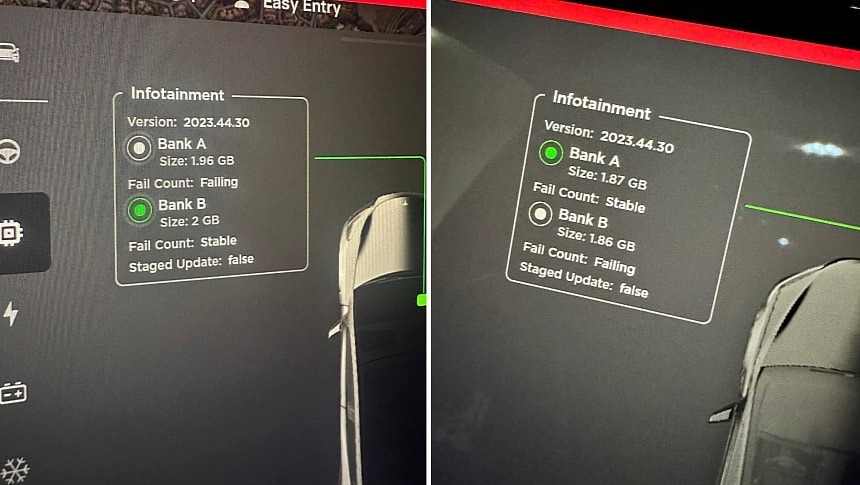Tesla pushed the FSD Beta V12.3 to more customer vehicles on Monday and Tuesday, making a lot of people happy. As the update's scope widened, the latest waves included Hardware-4 vehicles. However, some of the owners of those vehicles reported an unusually high rate of failed installs.
Last week, Tesla released FSD Beta V12.3 to the Wave1 beta testers. These are the first people outside of Tesla to test new software builds after Tesla employees give their OK. Wave1 testers are usually composed of friends and relatives of Tesla employees, and they are still bound by non-disclosure agreements, the same as Tesla employees.
Usually, we only get to see the first impressions about new software builds when they roll out to customer vehicles. That is, unless somebody leaks them, which has happened more than once. In the case of the latest FSD Beta iteration, the V12.3, we only heard general impressions during the Wave1 phase but not many details. However, as Tesla expanded the FSD Beta V12.3 rollout, the internet was filled with videos and reviews.
These have been mostly positive, pointing to impressive progress made by the end-to-end AI self-driving software. Although still far from perfect, FSD V12.3 behaves almost like a human in most situations. Even more surprising, it appeared to find creative solutions to delicate situations. This was the expected behavior, considering that neural networks control everything and they have the ability to learn and improve from both real-world driving and video simulations.
This success encouraged Tesla to push the update to more vehicles this week. As usual, the deployment happened in waves, which allowed Tesla to assess the impact on various groups. In the case of the V12.3, the first waves that got the update were Hardware-3 vehicles already on an FSD V12 build. Only recently, Tesla expanded the update to Hardware-4 vehicles, and that's when the problems appeared. This shows why it's important not to rush the update to as many vehicles as possible.
Based on a Teslascope report, the 2023.44.30.25 update registered an "above-average rate of install failures." Several Tesla owners reported that the update downloads, but it gets stuck at 100% and eventually disappears. Resetting the car doesn't solve the issue. A look inside the service mode screen shows "Failing" under either bank A or bank B of the file system. Software magician Green (@greentheonly) confirms this is a staging failure, and they have become more widespread with the 2023.44.30.x builds.
The issue impacted a small number of Hardware-4 vehicles and is being actively investigated. Usually, the solution for such failures is for Tesla to release a new update or a visit to a Tesla Service Center. The latter is also recommended if you encounter failed updates repeatedly. A faulty infotainment unit might cause it, and in this case, only a replacement will help. Hopefully, Tesla will solve this issue for those affected.
Usually, we only get to see the first impressions about new software builds when they roll out to customer vehicles. That is, unless somebody leaks them, which has happened more than once. In the case of the latest FSD Beta iteration, the V12.3, we only heard general impressions during the Wave1 phase but not many details. However, as Tesla expanded the FSD Beta V12.3 rollout, the internet was filled with videos and reviews.
These have been mostly positive, pointing to impressive progress made by the end-to-end AI self-driving software. Although still far from perfect, FSD V12.3 behaves almost like a human in most situations. Even more surprising, it appeared to find creative solutions to delicate situations. This was the expected behavior, considering that neural networks control everything and they have the ability to learn and improve from both real-world driving and video simulations.
This success encouraged Tesla to push the update to more vehicles this week. As usual, the deployment happened in waves, which allowed Tesla to assess the impact on various groups. In the case of the V12.3, the first waves that got the update were Hardware-3 vehicles already on an FSD V12 build. Only recently, Tesla expanded the update to Hardware-4 vehicles, and that's when the problems appeared. This shows why it's important not to rush the update to as many vehicles as possible.
Based on a Teslascope report, the 2023.44.30.25 update registered an "above-average rate of install failures." Several Tesla owners reported that the update downloads, but it gets stuck at 100% and eventually disappears. Resetting the car doesn't solve the issue. A look inside the service mode screen shows "Failing" under either bank A or bank B of the file system. Software magician Green (@greentheonly) confirms this is a staging failure, and they have become more widespread with the 2023.44.30.x builds.
The issue impacted a small number of Hardware-4 vehicles and is being actively investigated. Usually, the solution for such failures is for Tesla to release a new update or a visit to a Tesla Service Center. The latter is also recommended if you encounter failed updates repeatedly. A faulty infotainment unit might cause it, and in this case, only a replacement will help. Hopefully, Tesla will solve this issue for those affected.
We’ve seen an above-average rate of install failures for 2023.44.30.25, containing Full Self-Driving (Beta) V12.3.
— Teslascope (@teslascope) March 19, 2024
This is only impacting vehicles with HW4, and the majority of vehicles (99.997%) have installed the update without any problems. We are actively researching. https://t.co/VECwbZPeg4









